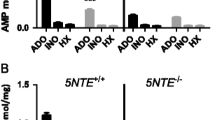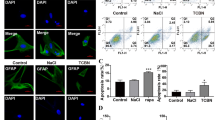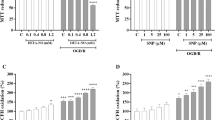Abstract
Glial cells are involved in multiple cerebral functions that profoundly influence brain tissue viability during ischemia, and astrocytes are the main source of extracellular purines as adenosine and guanosine. The endogenous guanine-based nucleoside guanosine is a neuromodulator implicated in important processes in the brain, such as modulation of glutamatergic transmission and protection against oxidative and inflammatory damage. We evaluated if the neuroprotective effect of guanosine is also observed in cultured cortical astrocytes subjected to oxygen/glucose deprivation (OGD) and reoxygenation. We also assessed the involvement of A1 and A2A adenosine receptors and phosphatidylinositol-3 kinase (PI3K), MAPK, and protein kinase C (PKC) signaling pathways on the guanosine effects. OGD/reoxygenation decreased cell viability and glutamate uptake and increased reactive oxygen species (ROS) production in cultured astrocytes. Guanosine treatment prevented these OGD-induced damaging effects. Dipropyl-cyclopentyl-xanthine (an adenosine A1 receptor antagonist) and 4-[2-[[6-amino-9-(N-ethyl-β-d-ribofuranuronamidosyl)-9H-purin-2-yl]amino]ethyl] benzenepropanoic acid hydrochloride (an adenosine A2A receptor agonist) abolished guanosine-induced protective effects on ROS production, glutamate uptake, and cell viability. The PI3K pathway inhibitor 2-morpholin-4-yl-8-phenylchromen-4-one, the extracellular-signal regulated kinase kinase (MEK) inhibitor 2′-amino-3′-methoxyflavone, or the PKC inhibitor chelerythrine abolished the guanosine effect of preventing OGD-induced cells viability reduction. PI3K inhibition partially prevented the guanosine effect of reducing ROS production, whereas MEK and PKC inhibitions prevented the guanosine effect of restoring glutamate uptake. The total immunocontent of the main astrocytic glutamate transporter glutamate transporter-1 (GLT-1) was not altered by OGD and guanosine. However, MEK and PKC inhibitions also abolished the guanosine effect of increasing cell-surface expression of GLT-1 in astrocytes subjected to OGD. Then, guanosine prevents oxidative damage and stimulates astrocytic glutamate uptake during ischemic events via adenosine A1 and A2A receptors and modulation of survival signaling pathways, contributing to microenvironment homeostasis that culminates in neuroprotection.






Similar content being viewed by others
Abbreviations
- A1R:
-
Adenosine A1 receptor
- A2AR:
-
Adenosine A2A receptor
- CGS21680:
-
4-[2-[[6-Amino-9-(N-ethyl-β-d-ribofuranuronamidosyl)-9H-purin-2-yl]amino]ethyl] benzenepropanoic acid hydrochloride
- DPCPX:
-
Dipropyl-cyclopentyl-xanthine
- ERK:
-
Extracellular signal-regulated kinase
- GLT-1:
-
Glutamate transporter-1
- GUO:
-
Guanosine
- HBSS:
-
Hank’s balanced salt solution
- KRB:
-
Krebs-Ringer bicarbonate buffer
- LY294002:
-
2-Morpholin-4-yl-8-phenylchromen-4-one
- MAPK:
-
Mitogen-activated protein kinase
- MEK:
-
Extracellular-signal regulated kinase kinase
- MTT:
-
3-(4,5-Dimethylthiazol-2-yl)-2,5-diphenyltetrazolium bromide
- OGD:
-
Oxygen/glucose deprivation
- PD98059:
-
2′-Amino-3′-methoxyflavone
- PI3K:
-
Phosphatidylinositol-3 kinase
- PKC:
-
Protein kinase C
- ROS:
-
Reactive oxygen species
References
Bonde C, Sarup A, Schousboe A, Gegelashvili G, Zimmer J, Noraberg J (2003) Neurotoxic and neuroprotective effects of the glutamate transporter inhibitor DL-threo-beta-benzyloxyaspartate (DL-TBOA) during physiological and ischemia-like conditions. Neurochem Int 43(4–5):371–380
Camacho A, Massieu L (2006) Role of glutamate transporters in the clearance and release of glutamate during ischemia and its relation to neuronal death. Arch Med Res 37(1):11–18
Trendelenburg G, Dirnagl U (2005) Neuroprotective role of astrocytes in cerebral ischemia: focus on ischemic preconditioning. Glia 50(4):307–320
Zhao Y, Rempe DA (2010) Targeting astrocytes for stroke therapy. Neurotherapeutics 7(4):439–451
Danbolt NC (2001) Glutamate uptake. Prog Neurobiol 65(1):1–105
Schousboe A, Waagepetersen HS (2006) Glial modulation of GABAergic and glutamatergic neurotransmission. Curr Top Med Chem 6(10):929–934
Guillet BA et al (2005) Differential regulation by protein kinases of activity and cell surface expression of glutamate transporters in neuron-enriched cultures. Neurochem Int 46(4):337–346
Sheldon AL, Robinson MB (2007) The role of glutamate transporters in neurodegenerative diseases and potential opportunities for intervention. Neurochem Int 51(6–7):333–355
Dienel GA (2013) Astrocytic energetics during excitatory neurotransmission: what are contributions of glutamate oxidation and glycolysis? Neurochem Int 63(4):244–258
Trotti D, Danbolt NC, Volterra A (1998) Glutamate transporters are oxidant-vulnerable: a molecular link between oxidative and excitotoxic neurodegeneration? Trends Pharmacol Sci 19(8):328–334
Ciccarelli R, Ballerini P, Sabatino G, Rathbone MP, D’Onofrio M, Caciagli F, di Iorio P (2001) Involvement of astrocytes in purine-mediated reparative processes in the brain. Int J Dev Neurosci 19(4):395–414
Uemura Y, Miller JM, Matson WR, Beal MF (1991) Neurochemical analysis of focal ischemia in rats. Stroke 22(12):1548–1553
Ciccarelli R, di Iorio P, Giuliani P, D’Alimonte I, Ballerini P, Caciagli F, Rathbone MP (1999) Rat cultured astrocytes release guanine-based purines in basal conditions and after hypoxia/hypoglycemia. Glia 25(1):93–98
Tasca CI, Lanznaster D, Oliveira KA, Fernández-Dueñas V, Ciruela F (2018) Neuromodulatory effects of guanine-based purines in health and disease. Front Cell Neurosci 12:376
Dal-Cim T, Martins WC, Santos ARS, Tasca CI (2011) Guanosine is neuroprotective against oxygen/glucose deprivation in hippocampal slices via large conductance Ca(2)+-activated K+ channels, phosphatidilinositol-3 kinase/protein kinase B pathway activation and glutamate uptake. Neuroscience 183:212–220
Dal-Cim T, Ludka FK, Martins WC, Reginato C, Parada E, Egea J, López MG, Tasca CI (2013) Guanosine controls inflammatory pathways to afford neuroprotection of hippocampal slices under oxygen and glucose deprivation conditions. J Neurochem 126(4):437–450
Thomaz DT, Dal-Cim TA, Martins WC, Cunha MP, Lanznaster D, de Bem AF, Tasca CI (2016) Guanosine prevents nitroxidative stress and recovers mitochondrial membrane potential disruption in hippocampal slices subjected to oxygen/glucose deprivation. Purinergic Signal 12(4):707–718
Dal-Cim T, Martins WC, Thomaz DT, Coelho V, Poluceno GG, Lanznaster D, Vandresen-Filho S, Tasca CI (2016) Neuroprotection promoted by guanosine depends on glutamine synthetase and glutamate transporters activity in hippocampal slices subjected to oxygen/glucose deprivation. Neurotox Res 29(4):460–468
Lanznaster D, Dal-Cim T, Piermartiri TCB, Tasca CI (2016) Guanosine: a neuromodulator with therapeutic potential in brain disorders. Aging Dis 7(5):657–679
Mendes-de-Aguiar CB et al (2008) Thyroid hormone increases astrocytic glutamate uptake and protects astrocytes and neurons against glutamate toxicity. J Neurosci Res 86(14):3117–3125
Pocock JM, Nicholls DG (1998) Exocytotic and nonexocytotic modes of glutamate release from cultured cerebellar granule cells during chemical ischaemia. J Neurochem 70(2):806–813
Hurtado O, Lizasoain I, Fernández-Tomé P, Álvarez-Barrientos A, Leza JC, Lorenzo P, Moro MA (2002) TACE/ADAM17-TNF-alpha pathway in rat cortical cultures after exposure to oxygen-glucose deprivation or glutamate. J Cereb Blood Flow Metab 22(5):576–585
Mosmann T (1983) Rapid colorimetric assay for cellular growth and survival: application to proliferation and cytotoxicity assays. J Immunol Methods 65(1–2):55–63
Molz S, Dal-Cim T, Tasca CI (2009) Guanosine-5′-monophosphate induces cell death in rat hippocampal slices via ionotropic glutamate receptors activation and glutamate uptake inhibition. Neurochem Int 55(7):703–709
Dal-Cim T, Molz S, Egea J, Parada E, Romero A, Budni J, Martín de Saavedra MD, Barrio L, Tasca CI, López MG (2012) Guanosine protects human neuroblastoma SH-SY5Y cells against mitochondrial oxidative stress by inducing heme oxigenase-1 via PI3K/Akt/GSK-3beta pathway. Neurochem Int 61(3):397–404
Constantino LC, Binder LB, Vandresen-Filho S, Viola GG, Ludka FK, Lopes MW, Leal RB, Tasca CI (2018) Role of phosphatidylinositol-3 kinase pathway in NMDA preconditioning: different mechanisms for seizures and hippocampal neuronal degeneration induced by quinolinic acid. Neurotox Res 34(3):452–462
Lowry OH et al (1951) Protein measurement with the Folin phenol reagent. J Biol Chem 193(1):265–275
Peterson GL (1977) A simplification of the protein assay method of Lowry et al. which is more generally applicable. Anal Biochem 83(2):346–356
Gegelashvili G et al (2000) The high-affinity glutamate transporters GLT1, GLAST, and EAAT4 are regulated via different signalling mechanisms. Neurochem Int 37(2–3):163–170
Decker H, Francisco SS, Mendes-de-Aguiar CBN, Romão LF, Boeck CR, Trentin AG, Moura-Neto V, Tasca CI (2007) Guanine derivatives modulate extracellular matrix proteins organization and improve neuron-astrocyte co-culture. J Neurosci Res 85(9):1943–1951
Lukaszevicz AC, Sampaïo N, Guégan C, Benchoua A, Couriaud C, Chevalier E, Sola B, Lacombe P, Onténiente B (2002) High sensitivity of protoplasmic cortical astroglia to focal ischemia. J Cereb Blood Flow Metab 22(3):289–298
Giffard RG, Swanson RA (2005) Ischemia-induced programmed cell death in astrocytes. Glia 50(4):299–306
Quincozes-Santos A, Bobermin LD, Souza DG, Bellaver B, Gonçalves CA, Souza DO (2014) Guanosine protects C6 astroglial cells against azide-induced oxidative damage: a putative role of heme oxygenase 1. J Neurochem 130(1):61–74
Giuliani P et al (2015) Guanosine protects glial cells against 6-hydroxydopamine toxicity. Adv Exp Med Biol 837:23–33
Bellaver B, Souza DG, Bobermin LD, Gonçalves CA, Souza DO, Quincozes-Santos A (2015) Guanosine inhibits LPS-induced pro-inflammatory response and oxidative stress in hippocampal astrocytes through the heme oxygenase-1 pathway. Purinergic Signal 11(4):571–580
Souza DG, Bellaver B, Bobermin LD, Souza DO, Quincozes-Santos A (2016) Anti-aging effects of guanosine in glial cells. Purinergic Signal 12(4):697–706
Nanetti L, Raffaelli F, Vignini A, Perozzi C, Silvestrini M, Bartolini M, Provinciali L, Mazzanti L (2011) Oxidative stress in ischaemic stroke. Eur J Clin Investig 41(12):1318–1322
Hansel G, Ramos DB, Delgado CA, Souza DG, Almeida RF, Portela LV, Quincozes-Santos A, Souza DO (2014) The potential therapeutic effect of guanosine after cortical focal ischemia in rats. PLoS One 9(2):e90693
Hansel G, Tonon AC, Guella FL, Pettenuzzo LF, Duarte T, Duarte MMMF, Oses JP, Achaval M, Souza DO (2015) Guanosine protects against cortical focal ischemia. Involvement of inflammatory response. Mol Neurobiol 52(3):1791–1803
de Oliveira DL et al (2004) Quinolinic acid promotes seizures and decreases glutamate uptake in young rats: reversal by orally administered guanosine. Brain Res 1018(1):48–54
Moretto MB, Arteni NS, Lavinsky D, Netto CA, Rocha JBT, Souza DO, Wofchuk S (2005) Hypoxic-ischemic insult decreases glutamate uptake by hippocampal slices from neonatal rats: prevention by guanosine. Exp Neurol 195(2):400–406
Molz S, Dal-Cim T, Budni J, Martín-de-Saavedra MD, Egea J, Romero A, del Barrio L, Rodrigues ALS, López MG, Tasca CI (2011) Neuroprotective effect of guanosine against glutamate-induced cell death in rat hippocampal slices is mediated by the phosphatidylinositol-3 kinase/Akt/glycogen synthase kinase 3beta pathway activation and inducible nitric oxide synthase inhibition. J Neurosci Res 89(9):1400–1408
Di Liberto V et al (2016) The guanine-based purinergic system: the tale of an orphan neuromodulation. Front Pharmacol 7:158
Volpini R, Marucci G, Buccioni M, Dal Ben D, Lambertucci C, Lammi C, Mishra RC, Thomas A, Cristalli G (2011) Evidence for the existence of a specific g protein-coupled receptor activated by guanosine. ChemMedChem 6(6):1074–1080
Zelenaia O, Schlag BD, Gochenauer GE, Ganel R, Song W, Beesley JS, Grinspan JB, Rothstein JD, Robinson MB (2000) Epidermal growth factor receptor agonists increase expression of glutamate transporter GLT-1 in astrocytes through pathways dependent on phosphatidylinositol 3-kinase and transcription factor NF-kappaB. Mol Pharmacol 57(4):667–678
Crossthwaite AJ, Hasan S, Williams RJ (2002) Hydrogen peroxide-mediated phosphorylation of ERK1/2, Akt/PKB and JNK in cortical neurones: dependence on Ca(2+) and PI3-kinase. J Neurochem 80(1):24–35
Brazil DP, Yang ZZ, Hemmings BA (2004) Advances in protein kinase B signalling: AKTion on multiple fronts. Trends Biochem Sci 29(5):233–242
Niizuma K, Yoshioka H, Chen H, Kim GS, Jung JE, Katsu M, Okami N, Chan PH (2010) Mitochondrial and apoptotic neuronal death signaling pathways in cerebral ischemia. Biochim Biophys Acta 1802(1):92–99
Krizman-Genda E, González MI, Zelenaia O, Robinson MB (2005) Evidence that Akt mediates platelet-derived growth factor-dependent increases in activity and surface expression of the neuronal glutamate transporter, EAAC1. Neuropharmacology 49(6):872–882
Sims KD, Straff DJ, Robinson MB (2000) Platelet-derived growth factor rapidly increases activity and cell surface expression of the EAAC1 subtype of glutamate transporter through activation of phosphatidylinositol 3-kinase. J Biol Chem 275(7):5228–5237
Frizzo ME, Frizzo JK, Amadio S, Rodrigues JM, Perry ML, Bernardi G, Volonté C (2007) Extracellular adenosine triphosphate induces glutamate transporter-1 expression in hippocampus. Hippocampus 17(4):305–315
Funding
Research was supported by grants from the Brazilian funding agencies: CAPES (Coordenação do Pessoal de Ensino Superior)—Project CAPES-PVE 052/2012; CNPq (Conselho Nacional de Desenvolvimento Científico e Tecnológico)—Project INCT for Excitotoxicity and Neuroprotection; and FAPESC (Fundação de Amparo à Pesquisa e Inovação do Estado de Santa Catarina)—Project NENASC. C.I.T. is recipient of CNPq productivity fellowship.
Author information
Authors and Affiliations
Contributions
All authors have materially participated in the research and/or article preparation.
Corresponding author
Ethics declarations
The procedures used in the present study complied with the guidelines on animal care of the UFSC Ethics Committee on the Use of Animals (CEUA), which follows the Principles of laboratory animal care from NIH (2011).
Conflict of interest
The authors declare that they have no conflict of interest.
Additional information
Publisher’s note
Springer Nature remains neutral with regard to jurisdictional claims in published maps and institutional affiliations.
Rights and permissions
About this article
Cite this article
Dal-Cim, T., Poluceno, G.G., Lanznaster, D. et al. Guanosine prevents oxidative damage and glutamate uptake impairment induced by oxygen/glucose deprivation in cortical astrocyte cultures: involvement of A1 and A2A adenosine receptors and PI3K, MEK, and PKC pathways. Purinergic Signalling 15, 465–476 (2019). https://doi.org/10.1007/s11302-019-09679-w
Received:
Accepted:
Published:
Issue Date:
DOI: https://doi.org/10.1007/s11302-019-09679-w




